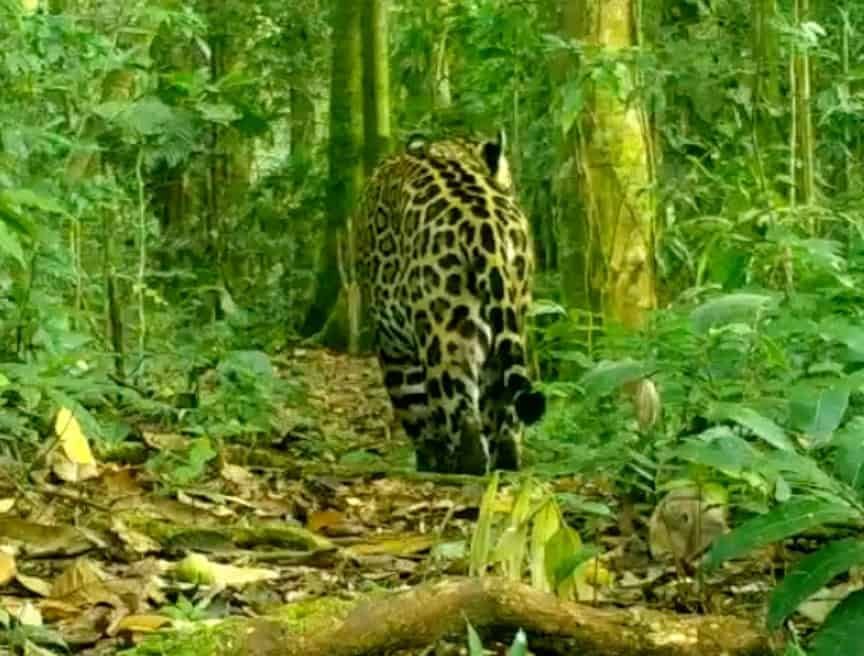Biodiversity credits, the new frontier
Biodiversity methodologies are the key to finding sustainable existence.
Humans naturally love the animals and plants that share our earth. Yet, the perverse incentives of many industries and the growing human population are decimating other species and entire ecosystems. Biocredits like biodiversity credits offer hope. Is it finally possible to account for the intangible value of biodiversity through this new mechanism?
A still image produced from camera trap video recording, Savimbo, Putumayo, Colombia
“When one tugs at a single thing in nature, he finds it attached to the rest of the world.”
Climate change isn’t just about carbon — animals are just as affected. As World Bank states in 2016, “Experts estimate the current loss of species to be between 1,000 and 10,000 times higher than the natural extinction rate. The global Living Planet Index (LPI) shows an overall species decline of 52% between 1970 and 2010. Our increasing demands on nature are driving the two biggest catastrophic threats to species decline- habitat loss and wildlife trade. Habitat loss is a threat to 85% of all species”.
But the precipitous decline of biodiversity isn’t just the loss of species. Biodiversity loss is an indicator of the loss of entire ecosystems including elements and water cycles. According to the World Wildlife Fund (WWF), Earth has lost half of its wildlife in the past 40 years. In the case of the Amazon, biodiversity loss means that the earth is losing functionality that impacts the entire planetary water cycle. More than half of the Amazon’s 80,000 species are critical for maintaining the water cycle. This is why a biodiversity methodology, such as biodiversity credits and biocredits, can help measure not only at-risk animals but also quantify ecosystem conservation.
In Colombia's Amazon region, the loss of the jaguar and the Amazon river dolphin signal destruction of huge swathes of land. These losses are tragic for nature but also carry profound implications for human life.
How can biodiversity credits help protect the planet?
Biodiversity loss can diminish ecosystem productivity, stability, and resilience. Humans rely on these ecosystems for the basic resources of life: air, water, food, and medicine. Despite the techno-utopian rhetoric, all raw materials for food come from the earth, not from a factory or laboratory. Up to 50% of the world's pharmaceuticals are derived from biodiversity, including plants and microorganisms. Healthy ecosystems purify the air and regulate the climate, preventing disasters such as floods and droughts. Simply put, human health depends on ecosystem health.
The importance of biodiversity is often underestimated. The destruction of one species causes a cascade effect. When a top predator declines or disappears, it leads to an overpopulation of its prey, which in turn depletes the plants or smaller animals they feed on. As one ecosystem fails, it affects neighboring ecosystems, impacting everything from global weather patterns to human food supplies.
Biodiversity credits are designed to provide a financial incentive for the conservation of diverse habitats and species. Biocredits are today’s best hope for securing the future of species like the jaguar, the river dolphin, the harpy eagle, and even plankton. A robust biodiversity methodology provides income to the people who spend their time protecting biodiversity.
Why is it crucial to apply the right biodiversity methodology?
Biodiversity credits are different from carbon credits. A carbon credit provides a generalized indication of the reduction of carbon emissions. Biocredits are specific. If you reduce a ton of carbon emissions, that is less carbon in the atmosphere for the entire planet. If you preserve biodiversity in one location, it can’t substitute for biodiversity in another location.
While carbon offsets are debatably an acceptable tradeoff in carbon neutral aims. (One company pays another to reduce carbon they cant.) No one in their right mind would say it’s okay to kill a chimpanzee if you save a polar bear. There is simply no acceptable way to allow biodiversity offsetting for rare or endangered species. This is why most reputable biodiversity methodologies only offer voluntary biodiversity credits, credits that cannot be used as an offset.
It’s obvious that a polar bear represents a completely different ecosystem than a chimpanzee. But what they both have in common is that they indicate an intact, and at-risk ecosystem. Because it is an apex predator, for it to survive all other species in the area have to be present. So the jaguar is a sentinel species, which is an indicator of an intact ecosystem.
Voluntary biodiversity credits are designed for one thing: providing income for the people who protect the environment. Until now, these people were forced to exploit natural resources to make a living. As the world recognizes the importance of paying for ecosystem services, the voluntary biodiversity credit market provides a way to finance this essential activity. Funding biocredits is part of the evolving economic order that takes into account natural ecosystem maintenance.
What do we need to consider in a biodiversity methodology?
“Biodiversity starts in the distant past and it points toward the future.”
Biodiversity credits, by their very nature, promote the conservation of entire ecosystems. A biodiversity methodology is measuring the species, but representing a full ecosystem that may stretch over hundreds of thousands of hectares. Biodiversity methodologies should:
Cover large enough areas to provide all of the needs of the species being identified.
Take into account the needs of indigenous people and local communities (IPLC) who protect the ecosystems.
Provide economic incentives for local communities to conserve or restore biodiversity
Specify whether the methodology applies to intact ecosystems or restoration of damaged ecosystems (or both).
Account for all stakeholders, including those with mining and logging rights.
Provide verifiable and science-based evidence of ecological outcomes.
Implement transparency of accounting for payments.
For biocredits to be truly effective, they must respect and incorporate the needs and rights of local communities. The people on the ground need fair remuneration for their work. This is particularly important in areas like the Amazon, where indigenous communities have been living in harmony with the land for thousands of years. Indigenous communities have witnessed the destruction of their people and sacred homeland and are neglected in many conservation efforts. Many current methodologies continue to be extractive in terms of how payments go to the administrators of the program rather than those people on the ground who preserve the ecosystems.
While biodiversity is a complex issue, compensating the local people who preserve the biodiversity has proven effective. Incorporating the needs of local communities requires detailed knowledge of local customs, rights, and practices. This approach ensures that biodiversity credits not only conserve ecosystems while providing economic incentives for local communities to continue their sustainable practices. This way, biodiversity credits can be a tool for both conservation and social justice, driving sustainable development while preserving nature's bounty.
Biodiversity methodology: the eco-weapon to end biodiversity loss
The involvement of the local community is key if we want to achieve effective results in a biodiversity methodology.
We can empower local and indigenous communities by providing biodiversity credits with simple, fair, and accurate biodiversity methodologies. (Shameless plug: like Savimbo’s indicator species biodiversity methodology!)
Biodiversity credits: To preserve intact ecologies, biodiversity credits add an important element to global conservation efforts. Biodiversity represents full ecosystems, including the people who inhabit those ecosystems.
Fair biodiversity credits: Participation of local and indigenous people in preserving biodiversity is the best method for preserving biodiversity. Therefore, biodiversity methodologies should incorporate local people as leaders in defining a biodiversity methodology that integrates with their lifestyle.
Savimbo indicator species biodiversity methodology: Savimbo integrates fair crediting systems, verifiable scientific evidence, and transparency to create biodiversity credits that directly support indigenous communities and preserve the world’s most precious natural resources.
As we forge this new path in biodiversity conservation, we see a future where every creature, large or small, finds its rightful place in the tapestry of life. Where the chorus of the rainforest, and the heartbeat of the earth continue undiminished. In this shared symphony of existence, Savimbo is not just a participant but a conductor, guiding the harmony towards a sustainable future. With a biodiversity methodology and the use of biodiversity credits, we can write the next chapter of our planet's story.
Written by Grace Rachmany and Drea Burbank. Grace is a science writer, and Drea is an MD technologist.

